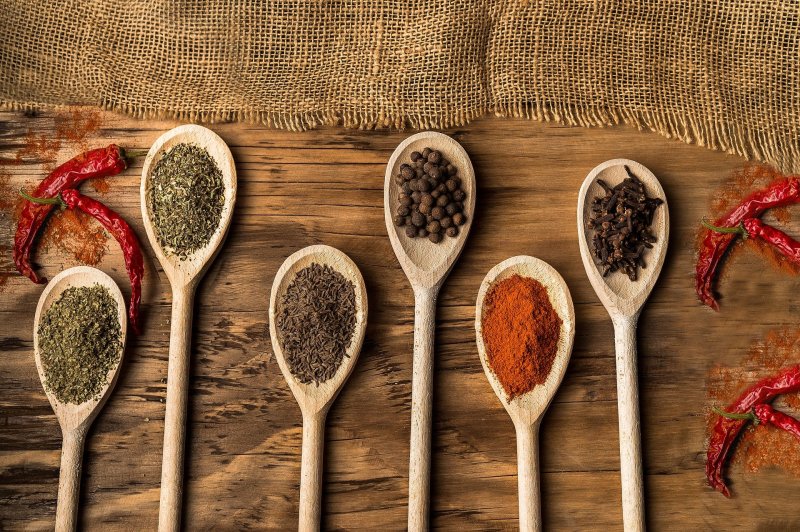Sweet, spicy, smokey, or savory — spices are the true unsung heroes, the heavy-hitters, and the “secret somethings” of kitchens across the globe. Spices emphasize and add dimension to the natural flavors of vegetables, fruits, meats, and grains. Specific blends of spices can also act as the foundation for an entire dish, as is the case in masalas, curries, and jerks. Spices are trademarks. The aroma, textures, colors, and flavors of each culture’s cuisine are unique due in no small part to the country or region’s traditional seasoning method.
There are a handful of commonly used spices that everyone should have in their kitchen. Salt, black pepper, garlic powder, onion powder, and chili powder are easily incorporated and found in cuisine all over the world. By adding a few new spices to the rotation, you can enjoy the bold, unique flavors of your favorite international cuisine from the comfort of your own home.
Cumin Powder

bdspnimage/Canva via Canva.com
Cumin powder is earthy and nutty with a hint of heat and lemon. This spice is a key ingredient in taco seasoning, garam masala (a spice blend), tikka masala (a spiced dish), and shawarma seasoning. Use cumin powder to emulate the flavors of Mexican, Indian, and Vietnamese foods. Try any of these amazing recipes to highlight the citrusy warmth of this deep golden spice.
No cumin? No problem. Check out these great alternatives.
Paprika

bhofack2/Getty Images Pro via Canva.com
Paprika comes from the chili pepper family, but this bright red spice doesn’t pack too powerful of a punch. There are a wide variety of flavor profiles for paprika, from spicy to sweet to smoked. Paprika is a staple in Hungarian, Cajun, and Spanish cuisine; it’s also an essential addition to creole seasoning or paella. Because paprika needs to be heated to release most of its flavor, it can be added as a garnish after cooking without a noticeable change in the dish’s overall flavor.
For paprika substitutes, look to other members of the Capsicum family.
Star Anise/Anise Seed

Image by Kai Reschke from Pixabay
Though similar in name, star anise and anise seed are two different spices with comparable flavor profiles (anise seed is considerably more potent). Both spices add a sweet, warm, licorice-like flavor to Chinese, Indian, and Middle Eastern foods. Use star anise or anise seed in Chinese 5-Spice powder, masalas, Thai teas, and pho. Anise also pairs well with cinnamon, nutmeg, and cloves for wintry-spiced desserts.
To recreate the mildly sweet licorice flavor of anise, try equal amounts of fennel, caraway seeds, or tarragon.
Turmeric

Image by Steve Buissinne from Pixabay
Turmeric is a vividly orange staple in many Asian and Middle Eastern cuisines. With a complex, rich, and woody flavor, turmeric is essential to most curries, masalas, and Persian and Middle Eastern stews. Turmeric is also lauded for its several health benefits. But use with caution – this deliciously pungent, mustardy spice can easily stain dishware, clothes, and countertops a bright yellow.
Use saffron to recreate turmeric’s saturated hue. For a flavor dupe, try cumin. To recreate its anti-inflammatory and digestive benefits, use ginger instead.
Cloves

Yana Gayvoronskaya/Canva via Canva.com
Sharply fruity and with a spicy warmth that’s almost numbing, cloves thrive in both savory and sweet dishes. Cloves are commonly used in Chinese, Greek, Indian, Eastern European, and Jamaican cuisines. It is a crucial component to Chinese 5-Spice powder, masalas, chai spice mixes, and Jamaican jerk dishes.
Allspice or allspice berries can be (and often are) used in place of cloves – both have very similar flavor profiles, with allspice offering a few more peppery undertones. Nutmeg or a combination of vanilla and cinnamon can also mimic the distinctly cozy flavor of cloves.
Cardamom

Image by scym from Pixabay
Hailed in India as the “queen of spices,” cardamom — a member of the ginger family — is light, lemony, and refreshing. Cardamom has been compared to a combination of black pepper and eucalyptus. The bright and spicy seasoning is a must for curry powders, garam masala blends, Lebanese baharat spices, and Ethiopian berbere. Like cloves, the mild sweetness and lingering warmth of cardamom make it an excellent addition to chai spice blends and baked goods.
Baking classics like cinnamon, nutmeg, and ginger can all be used in varying levels to replicate the slightly bittersweet tang of cardamom.
Dill Weed

bhofack2/Getty Images via Canva.com
Indigenous to Eastern Europe but no stranger to other areas of the planet, dill weed has been found in ancient Egyptian tombs, Roman ruins, and Neolithic lakeshore settlements. The buttery, grassy flavor of dill is used today in Greek, Asian, and American/Cajun cuisine. Dill is at the foundation of any authentic tzatziki sauce, Western European potato soup, and the classic: dill pickled cucumbers.
The crisp, earthy flavor of dill weed is best replicated by herbs like rosemary, thyme, and tarragon.
Celery Seed

skhoward/Getty Images Signature via Canva.com
Celery seed, a member of the Parsley family, is of Indian origin. However, the slightly bitter, floral, and hay-like flavor of celery seed has cemented its place in traditional American cuisine. Add celery seed to potato, egg, tuna, and macaroni salads; Old Bay seasoning; Chicago-style hot dogs; and your favorite seafood dishes. While it takes 45,000 of these tiny seeds to yield a single ounce, only a pinch will pack your dishes with loads of fresh, fragrant flavor.
- Simple Crockpot Chicken Noodle Soup
- Two-Tone Coleslaw with Celery Seed Yogurt Dressing
- Chicago-Style Hot Dogs
Celery salt can be used in the place of celery seed, but make sure to reduce any other salt in the recipe by at least half. Other ways to get a comparably punchy celery flavor is to use dill, nigella seeds, caraway seeds, or celery stalks.
